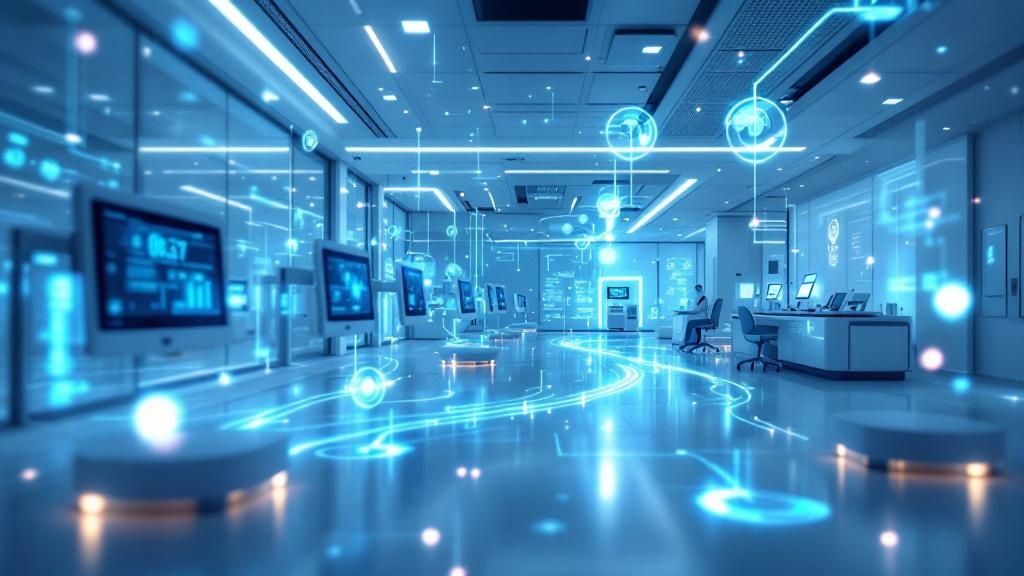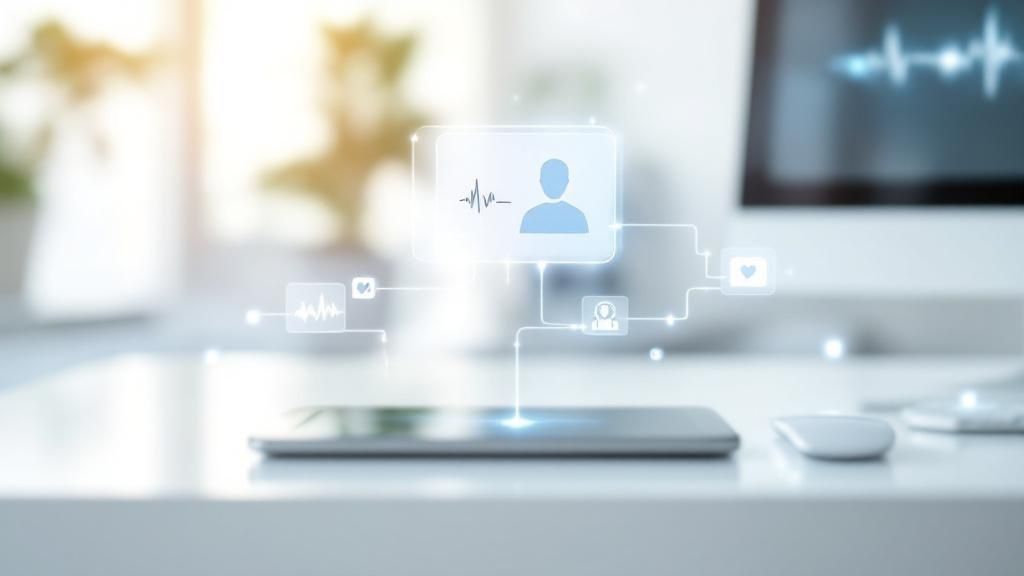At its core, healthcare interoperability is what allows different health information systems to talk to each other—to communicate, exchange data, and actually use the information that’s been shared. It’s the essential framework that enables seamless, secure, and coordinated patient care in a fragmented digital world.
Imagine your primary care doctor, a specialist, the local hospital, and your pharmacy could all see the same, up-to-the-minute version of your health story. That’s the promise of a truly connected healthcare system, a system where critical information flows freely to the right people at the right time. This guide will explore exactly what healthcare interoperability is, why it's so critical, and how it’s shaping the future of medicine.
What Is Healthcare Interoperability in Simple Terms

Let's use an analogy from banking. You can use your Bank of America card at a Chase ATM or link your accounts to a third-party app like Mint without a second thought. Why? Because all those different systems speak a common financial language, allowing your money to move securely and your information to be available right when you need it. This universal connectivity is something we take for granted in finance, but it's a relatively new frontier in healthcare.
Healthcare interoperability is the exact same concept, but for your health information.
It’s about much more than just hitting "send" on a file. It’s about making that data genuinely useful. Real interoperability means one system can send information to another, and the receiving system can understand and act on it without any special effort from the user. A truly interoperable system ensures that a lab result from one clinic is not just viewable but is also automatically integrated into the patient's chart in another hospital's system, complete with context and metadata.
A big part of this is enabling the smooth flow of real-time data. When this works, it helps prevent dangerous medical errors, gets rid of redundant tests, and gives clinicians the complete picture they need to care for you. It empowers them to make decisions based on a holistic view of your health, not just a fragmented snapshot from a single encounter.
The Four Levels of Healthcare Interoperability
Getting all these systems to talk to each other isn't an all-or-nothing deal. It's more like a journey with four distinct levels, as defined by the Healthcare Information and Management Systems Society (HIMSS). Each level builds on the one before it, creating a more connected and intelligent healthcare environment.
Here’s a simple breakdown of what those levels look like.
| Level of Interoperability | What It Does | Simple Analogy |
|---|---|---|
| 1. Foundational | Establishes a basic, secure pipe for data to get from Point A to Point B. It ensures connectivity but doesn't interpret the data. | Mailing a sealed letter. It arrives safely, but the recipient still has to be able to open and read it. |
| 2. Structural | Defines the format and structure of the data, so it’s organized consistently. This is about data syntax. | Everyone agrees to use the same fill-in-the-blanks template for a form. The receiving system knows where to find each piece of information. |
| 3. Semantic | Ensures the meaning of the data is understood by both systems, regardless of the software. This is about data meaning and codification. | Translating languages. The system doesn't just read "myocardial infarction"—it understands this term means "heart attack." |
| 4. Organizational | Aligns the policies, security, and legal rules needed for different organizations to trust each other and share data seamlessly. This includes governance, policy, and legal considerations. | Creating international trade agreements. It's the high-level governance that makes everything else possible. |
As you can see, each step adds a new layer of sophistication, moving from just sending data to actually sharing knowledge. Reaching semantic and organizational interoperability is the ultimate goal, as it allows for true care coordination across different health systems.
This layered approach is critical because it moves beyond simple data transfer. It ensures that complex health information is not only exchanged but also interpreted correctly, which is fundamental for safe and effective patient care. For medical practices, achieving higher levels of interoperability is a key part of any successful strategy for electronic health record optimization.
The Journey from Paper Files to Digital Silos

To really get why healthcare interoperability matters so much today, you have to rewind the clock. For decades, a person’s entire health story was documented on paper, tucked away in manila folders, and locked inside towering metal filing cabinets.
This system was straightforward but incredibly broken. Sharing information meant a clerk had to physically copy, mail, or fax pages from a chart. The whole process was slow, clunky, and riddled with errors—lost faxes and misplaced files were just part of the job. A patient's complete medical history was almost never in one place at one time. A trip to a specialist often meant starting from scratch, retelling your medical story and hoping nothing crucial was forgotten.
Then came the big shift: Electronic Health Records (EHRs). Spurred by government incentives like the HITECH Act of 2009, healthcare organizations rapidly adopted digital systems. Moving from paper to digital was a huge leap forward, promising to make patient data easier to access, read, and manage.
The Rise of the Digital Island
The first wave of EHRs fixed the paper problem, but they accidentally created a brand new one. Most of these early systems were built as closed loops. They worked beautifully inside the walls of a single hospital or clinic but were never designed to talk to the outside world.
This created thousands of isolated digital silos. Your family doctor's EHR couldn't communicate with the hospital's system, and neither could connect to your specialist's software. Each platform spoke its own private language, trapping crucial patient data on what were essentially disconnected digital islands. This was a direct result of a competitive market where EHR vendors prioritized proprietary systems over open connectivity.
The fallout from this fragmentation was immediate, and everyone felt it.
- Patients turned into human data couriers, forced to remember their entire medical history or carry printouts and imaging CDs from one appointment to the next.
- Doctors had to make critical decisions with only a partial view of a patient's health, which increased the risk of medical errors and clinician burnout.
- The system buckled under the inefficiency, leading to duplicate tests, wasted money, and frustrated staff. In fact, studies show that redundant testing alone costs the U.S. healthcare system over $20 billion a year.
The lack of connectivity meant that even though the records were digital, the fundamental problem remained. A patient's health story was still broken, scattered across dozens of incompatible systems. It became obvious that just digitizing records wasn't enough; the systems themselves had to learn how to talk to each other.
The Problem That Sparked a Movement
Picture a patient arriving in an emergency room, unconscious or unable to speak. Without access to their records from other doctors, the ER team is flying blind. They have no idea about the patient’s allergies, current medications, or chronic conditions—information that could mean the difference between life and death.
This exact scenario, playing out in hospitals everywhere, every single day, created an urgent demand for a real solution. The fractured digital landscape wasn't just an inconvenience; it was a danger to patients. It highlighted a critical flaw in the healthcare delivery model: information was trapped, and patient safety was compromised as a result.
This industry-wide challenge became the catalyst for creating universal standards like HL7 and FHIR. These were designed to finally build bridges between all the digital islands, with a clear goal: make sure a patient’s complete health story could travel with them, securely and instantly, no matter where they went for care.
How Health Systems Finally Learned to Talk to Each Other

For years, healthcare systems were like islands, each speaking its own private language. The challenge was massive: how do you get thousands of different software platforms, built by competing companies over decades, to actually talk to each other? The answer wasn't a single piece of software, but a shared rulebook: interoperability standards.
Think of these standards as a universal translator for health data. They set the ground rules for how information—a patient's name, a lab result, a diagnosis—should be structured so that any system playing by the same rules can understand it. This was the critical first step to breaking down the digital walls between hospitals, clinics, and labs.
From a Clunky Past to a Flexible Future
Finding this common ground didn't happen overnight. The first attempts were powerful for their time, but they were often rigid and a headache to implement.
- HL7 Version 2 (V2): This was one of the earliest wins and is still a workhorse in many hospitals. Developed in the late 1980s, it was great for getting data from one system to another within the same building, such as from a lab information system to an EHR. However, its pipe-and-hat-based syntax was complex and required custom, one-off interfaces for each connection, making it difficult to scale.
- Clinical Document Architecture (CDA): This standard shifted the focus to creating shareable clinical documents, like a discharge summary or a referral note. It made entire patient records more portable by structuring them in a standardized XML format. While an improvement, CDAs were often lengthy, complex documents, not built for the quick, targeted data requests that modern apps need.
These early standards were necessary stepping stones, but the industry was hungry for something more nimble and developer-friendly. That need sparked a genuine breakthrough.
FHIR: The Game-Changer for Health Data
The most important leap forward in healthcare interoperability is, without a doubt, FHIR (Fast Healthcare Interoperability Resources). Pronounced "fire," this standard completely rewired how we think about accessing and using health data.
Instead of dealing with clunky messages or entire documents, FHIR breaks everything down into individual "resources"—think of them like LEGO blocks. A patient is a resource. An appointment is a resource. So is a prescription, an allergy, or a lab result.
This approach means a developer can build an app that asks for only the specific blocks it needs. A scheduling app can simply request the "appointment" and "patient" blocks, without having to sort through an entire medical record.
This resource-based model is so effective because it’s built on the same modern web technologies that power sites like Google and Facebook. It uses APIs (Application Programming Interfaces) that are familiar to modern developers. Suddenly, developers could build health apps, patient portals, and new clinical tools that securely "plug into" different EHR systems with far less effort than before. It’s the engine that lets an app on your phone safely pull your latest lab results from your doctor's EHR.
Today, FHIR is at the core of true interoperability. It is mandated by federal regulations like the 21st Century Cures Act. Most healthcare organizations now use it for a huge range of tasks, from simple document exchange to innovative digital tools for managing prescriptions and care referrals in real-time. If you want to dive deeper into how it's being used across the globe, you can explore the latest findings on FHIR's global state.
Ultimately, FHIR provides the technical foundation for a more connected and intelligent health system. It's the universal translator that finally allows all the different systems to speak the same language, making patient data more accessible, secure, and genuinely useful for improving care.
What Connected Healthcare Means for You

All the technical standards and data formats are just the plumbing. They're the engine making everything work behind the scenes, but they aren't the destination. The real point of all this is to build a healthcare system that's smarter, safer, and truly centered around you, the patient.
When data can move freely and securely, the benefits stop being theoretical and start becoming real for everyone. For most of us, the answer to what is healthcare interoperability comes alive when we see how it smooths out our own care journey. It’s the difference between a disjointed, frustrating mess and a coordinated, seamless experience.
A Safer, More Convenient Patient Experience
Think about the last time you saw a new specialist. Instead of trying to remember every medication and procedure while filling out a mountain of paperwork, what if you could just give your consent and have your entire health record appear on their screen? That’s not science fiction; it’s exactly what interoperability delivers.
This connected reality brings a few huge improvements:
- Fewer Repeated Tests: When your new cardiologist can see the blood work your primary care doctor ordered last month, you get to skip another needle stick and an unnecessary bill.
- Better Medication Management: Imagine your pharmacist, family doctor, and surgeon all looking at the exact same medication list. This dramatically cuts the risk of dangerous drug interactions.
- Empowered Health Management: You can pull up your own lab results on a phone app, schedule appointments, and easily share your records with any provider you choose. You’re in the driver’s seat.
- Smoother Transitions of Care: When you are discharged from a hospital, your primary care physician automatically receives a detailed summary, ensuring seamless follow-up care and reducing the risk of readmission.
A connected health record means your care team is always on the same page. In an emergency, first responders and ER doctors can get immediate access to your allergies and conditions, which can be life-saving.
A Clearer Picture for Doctors and Nurses
For clinicians on the front lines, interoperability is the cure for information chaos and a major source of burnout. It’s shocking how much time doctors and nurses spend—sometimes hours every single day—just hunting down patient records, lab results, and imaging reports stuck in some other clinic's system.
A fully connected system completely flips that script.
When a provider can pull up a complete patient history with a single click, it changes everything. They can make better clinical decisions because they have the full story, from an allergy noted by a family doctor years ago to a discharge summary from a recent hospital stay. This comprehensive view helps avoid misdiagnoses and ensures treatment plans are based on complete information.
This clarity doesn't just improve the quality of care; it also eases the crushing administrative load that drives so many providers to burn out. Less time chasing faxes means more time actually talking to and caring for patients.
This push for efficiency is why the global health data interoperability market is already worth tens of billions of dollars and growing fast. Health systems are demanding these tools to build better, more coordinated care. You can find more details on the health data interoperability market to see the economic forces pushing this forward.
A Stronger Public Health System
The benefits of interoperability reach far beyond a single doctor's visit. On a much larger scale, it gives public health officials the tools they need to protect entire communities.
When health systems can share anonymized data quickly and securely, it unlocks the ability to:
- Track Disease Outbreaks: Officials can spot emerging hotspots for illnesses like the flu or COVID-19 in near real-time, allowing for a much faster and more focused response.
- Monitor Health Trends: Researchers can analyze population-level data to understand patterns in chronic diseases and pinpoint communities that might be at higher risk.
- Improve Health Equity: By seeing where disparities in care and outcomes exist, public health agencies can direct resources and support to the people who need them most.
Ultimately, connected healthcare builds a system that can learn and adapt. It turns millions of isolated data points into a powerful, collective intelligence that helps individual patients, supports our hardworking clinicians, and strengthens the health of society as a whole.
The Toughest Roadblocks on the Path to Seamless Data
If interoperability is such a clear win for healthcare, why isn't it already the standard everywhere? That's the million-dollar question. The truth is, the path to a truly connected healthcare system is littered with some serious, complex roadblocks.
These aren't simple problems you can fix by just installing new software. We're talking about deep-seated technical, financial, and even cultural challenges that have been building up for decades. For most healthcare organizations, this journey is a marathon, not a sprint.
The Anchor of Outdated Systems
One of the biggest technical headaches is the problem of legacy systems. Many hospitals and clinics are still running on software that was built long before anyone was seriously thinking about sharing data. Think of these systems like digital fortresses—they’re stable and reliable on the inside, but they were never designed to open their gates to the outside world.
Trying to connect these old platforms with modern, API-driven technology is a nightmare. It’s a bit like trying to plug a vintage rotary phone into the latest smartphone. They don't speak the same language, and forcing them to communicate requires custom, expensive workarounds that are often fragile and a pain to maintain. This technical debt slows down progress significantly.
Financial and Organizational Hurdles
Beyond the tech, the financial and organizational barriers are just as daunting. Upgrading or completely replacing an electronic health record (EHR) system can cost a hospital millions of dollars. That kind of money is often out of reach for smaller private practices and rural healthcare facilities.
On top of that, old business models sometimes created a culture where sharing data was actively discouraged. In a competitive market, some organizations treated patient data like a private asset, not a shared resource that could improve everyone's care. While that mindset is slowly changing, it takes real time and strong leadership to shift an entire organization's culture toward open collaboration. This practice, known as "data blocking," has been a major impediment and is now being addressed by federal regulations.
The challenge of making healthcare data flow freely isn't just a U.S. problem. Global healthcare interoperability is a mixed bag, with some countries excelling thanks to centralized health platforms, while others struggle with infrastructure and governance. You can find more insights about these global healthcare connectivity challenges on accessnewswire.com.
The Critical Challenge of Privacy and Governance
Maybe the most sensitive roadblock of all is patient privacy and data security. As it gets easier to share information, the responsibility to protect that information grows tenfold. Every single connection point between two systems is a potential weak spot that has to be locked down against security breaches.
Getting everyone to agree on a consistent set of rules and governance is another huge challenge. Before they can share data safely, all organizations need a common playbook for things like:
- Patient Consent: How and when do patients give their permission to share data?
- Data Security: What are the baseline security standards everyone must follow?
- Identity Verification: How does one system know for sure it’s talking to a legitimate, authorized person from another system? Patient matching is a persistent problem, with duplicate records causing confusion and errors.
Figuring all this out is incredibly complex, especially with strict regulations like HIPAA setting the rules for privacy and security. Staying compliant isn't optional, and the fear of massive fines for a data breach makes many organizations nervous about opening up their systems. For anyone navigating these waters, it's a good idea to work through a detailed HIPAA compliance checklist to make sure all your bases are covered.
Solving these problems is what the interoperability movement is all about. It’s going to take a team effort from technology companies, healthcare providers, and government policymakers to build a future where data is both open and secure.
How Interoperability Fuels the Future of AI in Healthcare
Solving the interoperability puzzle isn’t just about fixing today’s data headaches—it’s about laying the groundwork for the next generation of medicine. The future of healthcare is undeniably tied to artificial intelligence (AI), but even the most advanced algorithm is powerless without its essential ingredient: massive amounts of clean, connected data.
This is where the real impact of interoperability shines. Think of it as the essential plumbing that collects fragmented health information from countless silos and transforms it into the high-octane fuel that intelligent systems need to run. Without it, AI is left trying to solve a complex puzzle with most of the pieces missing. With it, AI can finally see the full picture of a patient's health.
Unlocking Smarter, More Predictive Healthcare
When AI algorithms can finally access comprehensive, interoperable data, they can begin to uncover subtle patterns and connections that are simply invisible to the human eye. This opens up a world of possibilities for improving care. For a deeper dive into this, you can explore resources on AI and Business Intelligence (BI) in healthcare analytics.
This connected data ecosystem allows AI to tackle tasks that could fundamentally change how medicine is practiced:
- Sharpening Clinical Diagnoses: AI can comb through medical images, lab results, and patient histories to flag potential issues a doctor might need to investigate further, leading to faster, more accurate diagnoses.
- Predicting Disease Risks: By analyzing population-level data, AI models can identify patients at high risk for serious conditions like sepsis or heart failure, often long before obvious symptoms appear.
- Personalizing Treatment Plans: AI can assess a patient’s unique genetic profile, lifestyle, and medical history to help clinicians pinpoint the most effective treatment, pushing medicine toward a truly personalized approach.
- Optimizing Hospital Operations: From predicting patient admission spikes to optimizing surgical schedules and managing inventory, AI can make healthcare facilities run more smoothly and cost-effectively.
The core idea is simple: Better data leads to smarter AI, and smarter AI leads to better health outcomes. Interoperability is the critical bridge that connects that raw data to life-saving insights.
From Data to Actionable Insights
We’re already seeing platforms that put this principle into action. They build a seamless pipeline where interoperability standards like FHIR feed structured, usable data directly into AI engines. These systems don't just crunch numbers; they interpret the information and present it to clinicians in a way that’s genuinely helpful. For example, the synergy between artificial intelligence and electronic health records is already creating huge efficiencies for medical practices.
Ultimately, achieving seamless data flow isn't just a technical exercise. It’s the foundational step toward building a healthcare system that is more predictive, personalized, and efficient for everyone. By finally cracking the interoperability challenge, we’re setting the stage for a new era of intelligent medicine.
Common Questions About Healthcare Interoperability
Even after getting the basics down, a few practical questions always seem to pop up. Let's tackle some of the most common ones to help connect the dots and clear up any lingering confusion.
How Does Interoperability Actually Improve My Care?
At the end of the day, true interoperability makes your entire healthcare journey safer and more efficient. Think about it: when your primary doctor, a specialist you saw once, and the emergency room team can all see the same complete health record, the risk of dangerous mistakes drops dramatically.
This means no more dangerous drug interactions because everyone is looking at the same medication list. It also saves you from repeating expensive—and sometimes uncomfortable—tests just because your new doctor can’t access your recent lab results.
Simply put, a connected record means your care team isn't flying blind. They have the full picture of your health history, leading to better diagnoses, more effective treatments, and a much safer experience for you.
What Is the Difference Between an EMR and an EHR?
You’ll hear the terms Electronic Medical Record (EMR) and Electronic Health Record (EHR) thrown around a lot, often as if they mean the same thing. They don't, and the difference is crucial for understanding what interoperability is all about.
- An EMR (Electronic Medical Record) is really just a digital version of the paper chart you’d find at a single doctor's office. It’s an internal tool for that one practice to track your health over time. It is not designed to be shared outside the practice.
- An EHR (Electronic Health Record) is the whole story. It’s designed to pull together your records from all your doctors, hospitals, and clinics, creating a comprehensive view of your health that can be securely shared across different healthcare settings.
So, while EMRs keep information locked in one place, EHRs are built for sharing. They are the foundation that makes genuine interoperability possible.
How Is My Patient Data Kept Secure When Shared?
This is, without a doubt, one of the biggest and most important questions. Protecting your privacy isn't just a good idea; it's the law, thanks to strict regulations like the Health Insurance Portability and Accountability Act (HIPAA).
Interoperability doesn’t create a free-for-all with your data. Information is only shared between trusted healthcare providers through secure, encrypted connections specifically for your treatment. Every single organization involved has to follow strict rules to safeguard your information.
On top of that, modern systems use verifiable audit trails, strong identity checks, and clear patient consent rules. This creates a secure and responsible environment where every access to your data is tracked and authorized, ensuring it’s shared only to improve your care.
By automating tasks like appointment scheduling and prior authorizations, Simbie AI helps practices use their connected data to cut down on administrative work and focus on patient care. Learn how our clinically-trained voice agents can integrate with your EHR to create a more efficient workflow at https://www.simbie.ai.

